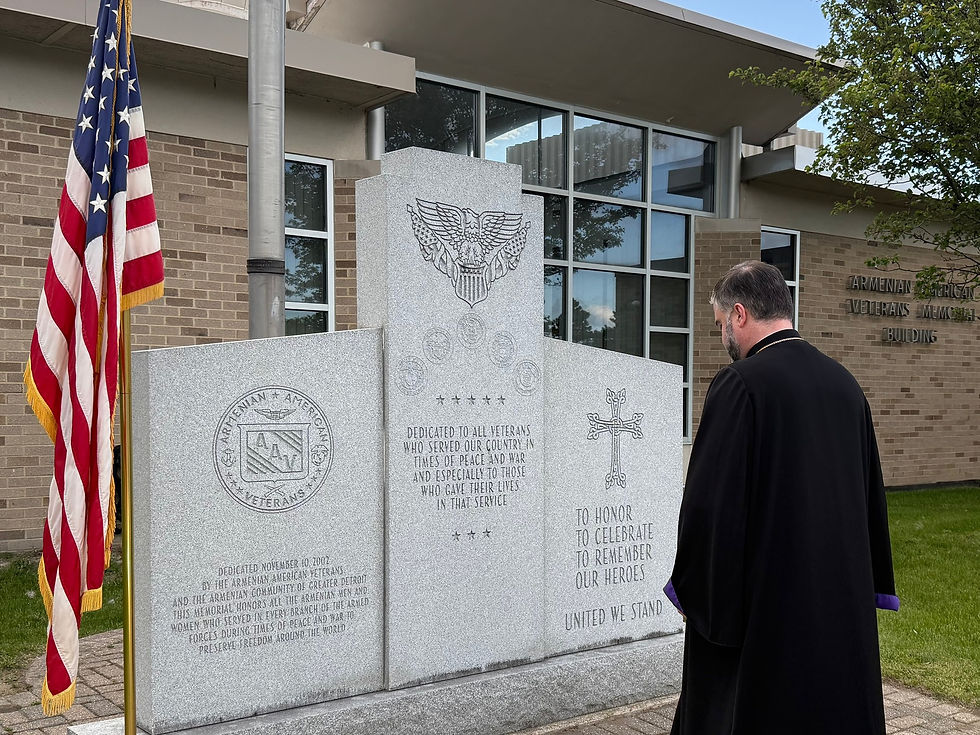St. Vartan and the Battle of Avarayr
- Bishop Mesrop Parsamyan

- Feb 21, 2017
- 3 min read

St. Vartan is considered one of the most famous heroes of the Armenian people. He, along with a brave band of Armenian soldiers, clergy, and companions, resisted the more powerful and larger Persian army and sacrificed their lives in order to defend their Christian faith. The famous battle took place on May 26, 451 A.D. on the plains of Avarayr, in the province of Artaz in Armenia.
Very few biographical details exist about St. Vartan's early life. However, various sources confirm his noble lineage. He was the grandson of St. Sahag, who, in turn, descended from St. Nerses, and ultimately his lineage is traceable to St. Gregory the Illuminator. His father, Hamazasp, was the sparapet, or commander-in-chief, of Armenia at that time.
St. Vartan was well educated, most likely, by his grandfather, Catholicos Sahag. Instead of entering the priesthood as others in his family had done, he became a soldier. St. Vartan was considered the worthy representative and head of the Mamikonian clan, which in the royal succession of Armenian kings, held the fifth position. He was respected by the King of Persia as the commander-in-chief of the Armenian armies. Equally important as St. Vartan's dedication to being a good soldier was St. Vartan's dedication to being a faithful Christian. He believed that one cannot serve one's people without serving Christ at the same time.
However, the political situation in Armenia during the mid-5th century made it increasingly difficult for Christian-Armenians to practice their faith. The Persians, who occupied the various Armenian regions, initially allowed the Armenians to retain their own rules and practices. However, because of the Armenians' growing zeal for their religion and the consequent loss of Persian influence, the Persians retaliated.
The Persian ruler, King Yazdigerd II, was a ruthless, evil person, who was fanatically opposed to Christianity. He was particularly cruel to the Armenians. He imposed unfair taxes and demanded that the Armenians abandon their religion and submit to the precepts of the pagan Persian religion (Zoroastrianism) and its worship of fire.
It was during this time a decree was sent out demanding that Armenians convert to Zoarastrianism. In response, Armenian bishops, led by St. Leontius as well as St. Vartan, called a council at Ardashad and unanimously agreed to defend their faith at all costs. They sent their declaration of faith to the king, who became more enraged and issued further threats.
Ultimately the brave Christians led by St. Vartan were forced to fight against the Persians. Numerous accounts exist describing the undying faith of these Christian warriors as they prepared for battle. They prayed, recited the Twenty-Third Psalms, shared their food, and took communion together as they waited to face the powerful Persian army, which outnumbered them.
The battle has been described as bloody and horrendous. Although St. Vartan, along with many of his comrades, suffered defeat and died, their fight to defend their faith was not in vain. The Persians eventually stopped their efforts to convert Armenia to Zoroastrianism.
The Feast of Vartanantz, commemorated on the Thursday preceding Great Lent, is both a religious and nationalistic one. It is a symbol of the conscience, the faith, and the general rebellion of Armenians against tyranny, and their effort to preserve their identity and freedom. Although St. Vartan, as leader and patriot emerged as the most revered figure, the many other commanders, priests, and companions who numbered over 1,036 are also remembered on this feast day for their martyrdom. Many churches throughout the Diaspora have been named after the Vartanian saints, including St. Vartan Armenian Cathedral in New York City. In Yerevan, an inspiring statue of St. Vartan, mounted on his horse, stands on a main thoroughfare, a continuing presence in the life of Armenians.
Source: armenianchurch-ed.net








Comments